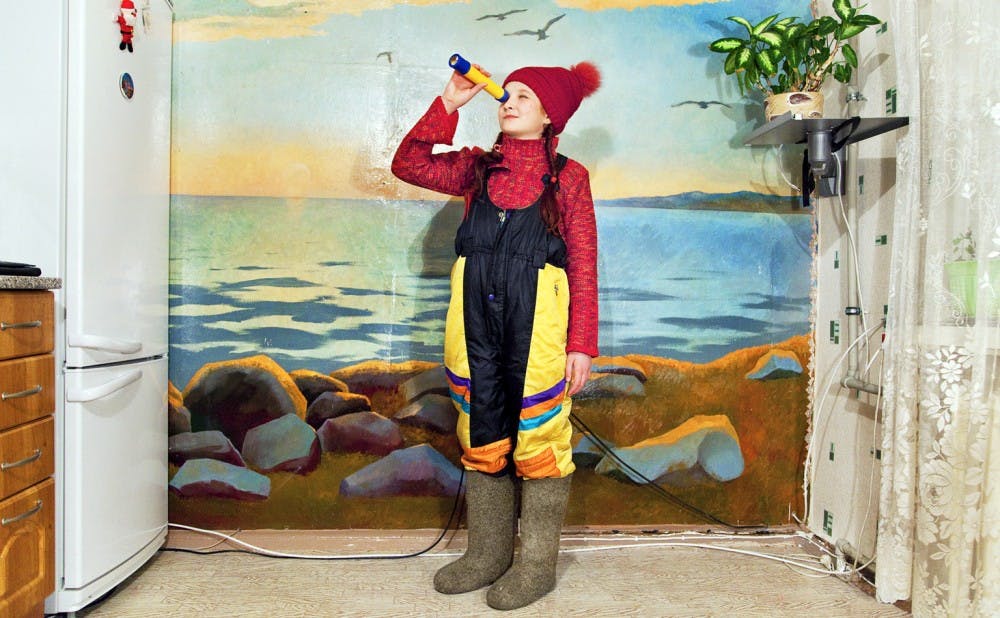Tiksi translates to “a moorage place” in the Yakut language spoken in Russia’s northeastern Sakha Republic, located on the Arctic coast of Siberia. It’s a fitting name for the remote town Evgenia Arbugaeva photographed as part of her collection, which is currently on display at the Center for Documentary Studies.
Arbugaeva is presently an artist-in-residence at Duke through a program administered by a partnership between the Magnum Foundation Emergency Fund and Duke’s Center for International Studies. The goal of the partnership is to connect international artists with the Duke and Durham community while exploring social issues through photography.
Arbugaeva was born in Tiksi in 1985 and spent her childhood there. At age eight, she and her family moved to a larger city upon the Soviet Union’s collapse, but Arbugaeva never forgot the beauty she saw in her icy hometown. Arbugaeva studied art management at the International School of Moscow and later moved to New York where she graduated from the International Center of Photography’s photojournalism and documentary program in 2009. She returned to Tiksi shortly after to rediscover her distanced birthplace.
During the Soviet Union’s peak, Tiksi was a vital military and scientific hub that drew residents from across the vast state. Some sought employment opportunities, but Arbugaeva writes in her artist's statement that others were attracted to a “romantic dream of the far North.” On one hand, the port town appears to be barren, post-industrial and perhaps even dystopic, especially in light of the pop culture-ridden context of binarizing the present United States with the former Soviet Union. Through this exhibit, though, Tiksi ends up looking like an endearing Arctic town (Iceland’s tourism board should take notes), teeming with a multitude of colors that naturally glow on its snowy canvas.
Upon returning to Tiksi, Arbugaeva took on 13-year-old Tanya as her muse, guide and subject of many photographs. Though never made explicit, Tanya appears as an extension of Arbugaeva herself, something like a teenage analogue of the child that left the town in the '90s. Coincidentally enough, Tanya’s family moved away to a larger city in the fall of 2012, as they saw no future in such a remote town.
Most captivating about this collection is that even the smallest amounts of color appear to pulse with animation, particularly when set against the abounding grays and whites, characteristic of Tiksi’s tundric landscape. This is especially apparent in shots featuring the town’s industrial-yet-quaint skyline. While the buildings’ paint jobs have faded with time, they strike a sweet, palpable contrast against the brutal cold.
Other photographs in the series focus solely on human subjects. These pieces feature exaggerated and mismatched color palettes and warm, zoomed-in frames that give the viewer a sense of closeness with the subjects. One photo shows Tanya dressed as Jacques Cousteau in her family’s kitchen. Dawning heavy snow gear and a blood-red beanie, Tanya aims a miniature telescope toward the sky and smiles. “Tanya in a tutu” shows the viewer just that: it's one of the few photos in the series that allows the viewer to forget about Tiksi's unforgiving landscape and climate. Wearing wool socks and the same smile, Tanya sits in bed as soft light floods the room, exposing its dated furniture and more inconspicuous features, like the wrinkled clothes drying on the radiator.
“After school” highlights Arbugaeva’s ability to render Tiksi’s otherwise mundane happenings as gripping still lifes. The photo shows three children running in the snow, presumably on their way home from school. Their bodies are swallowed in thick black jackets, obscuring their delicate figures that are still acutely visible in opposition to the background’s eggshell yellow building.
“A cemetery of old ships” is one of the grander photos in the series, showing Tanya with arms spread at the prow of an abandoned ship. Arbugaeva’s documentary technique gives the photo a surreal quality, but only because it presents something so astonishing in an unapologetic way.
This matter-of-factness can be said for the collection as a whole. It shows us a place so radically distant from our everyday without romanticizing; instead, it simply captures Tiksi and its people in their most commonplace state. In some ways, this collection is about our everyday versus theirs.
“Tiksi: Photographs by Evgenia Arbugaeva” debuts at the Center for Documentary Studies tonight, Nov. 14, at 6 p.m. A reception and talk with Evgenia Arbugaeva will follow. For more information, visit http://www.cdsporch.org/.
Get The Chronicle straight to your inbox
Signup for our weekly newsletter. Cancel at any time.

